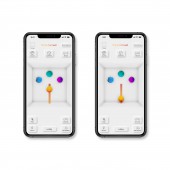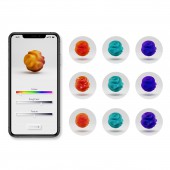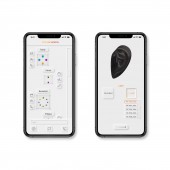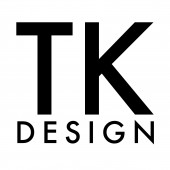Dinkum Mobile Application by Tobias Kappeler |
Home > Winners > #127093 |
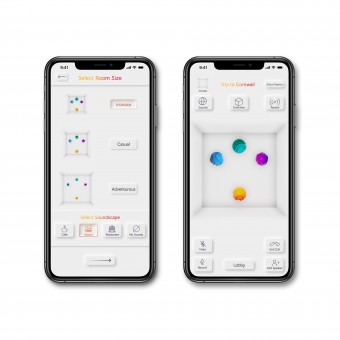 |
|
||||
| DESIGN DETAILS | |||||
| DESIGN NAME: Dinkum PRIMARY FUNCTION: Mobile Application INSPIRATION: Throughout the pandemic, I realised the difficulties of remote collaboration and the lack of attention to the audio side of the experience. We are flooded with visual stimuli but a lot of these experiences lack the emotional aspect of the experience. User research and secondary research into spatial audio technologies strongly informed the development. As a music producer and DJ, I’m fascinated by the emotional characteristics of audio. UNIQUE PROPERTIES / PROJECT DESCRIPTION: Dinkum is a spatial audio communication tool that allows users to immerse themselves in customisable audio environments. Users can select from three room sizes (intimate, casual, adventurous) and different ambisonic (full-sphere surround sound format) background sounds that match the type of conversation and people they are speaking to. People can change their distance to other participants throughout the conversation, which adds an extra layer of interaction to remote conversations. Dinkum can increase participants sense of presence and intimacy in the conversation and increase conversation fluency. OPERATION / FLOW / INTERACTION: To start a conversation, select the participants you want to speak to, select the room size which matches your conversations and participants, (Intimate, Casual, Adventurous) select the ambisonic background sounds and then start the call. Users can leave the room and create a new room during the conversations with individual participants. For recurring conversations, users can save groups and settings. In case a conversation drastically changes the topic. PROJECT DURATION AND LOCATION: The project started in January 2021 and was developed by myself for my MA/MSc Innovation Design Engineering until June 2021. The project will be exhibited at the yearly graduation show of the Royal College of Art and Imperial College London in June 2021. |
PRODUCTION / REALIZATION TECHNOLOGY: The project was developed through iterative prototyping, intensive user testing and a strong collaboration between academia and industry. I used different plugins for the spatialisation of mono audio files in a DAW (Digital Audio Workstation) and tested the experiences with different people. Furthermore, I built a binaural microphone for in-depth user testing with multiple people. I established a signal-processing path that allowed me to test with various users while being remote. SPECIFICATIONS / TECHNICAL PROPERTIES: Dinkum was developed using the 3D Tune-In Toolkit real-time binaural spatialisation tool. This was utilised as a VST plugin within Ableton Live. The 3D Tune in Toolkit simulates the reverberation of different room sizes, the distance to the listener and the direction to the sound source. For user testing, I’ve developed a signal processing path that allows me to send an audio recording from a binaural microphone through Zoom. TAGS: Communication, Spatial Audio, Interaction design, Immersive experiences, Audio & Sound, Mobile application, Teleconferencing, Conversations, RESEARCH ABSTRACT: The project started with an academic literature review and interviews on real-time spatialisation technologies. After intensive ideation on different applications, I moved into early experimentation and prototyping to get a better feel and understanding of the technology and its value. I used an iterative and human-centred design approach focusing on the experience. Experiments were analyzed with questionnaires with a Likert scale focusing on the presence and intimacy. CHALLENGE: The challenge was to create an environment that allowed me to test with the necessary fidelity and change the audio in real-time. An additional challenge was the visual representation of a 3D space with characters on a small smartphone screen which is easy to understand, interact with and is visually pleasing and unique. I overcame this through prototyping the interactions on the phone while affecting the audio and visual interface in real-time through OSC protocol and user feedback. ADDED DATE: 2021-06-19 18:54:22 TEAM MEMBERS (1) : Tobias Kappeler IMAGE CREDITS: Tobias Kappeler, 2021. |
||||
| Visit the following page to learn more: https://bit.ly/3wNOXy8 | |||||
| AWARD DETAILS | |
 |
Dinkum Mobile Application by Tobias Kappeler is Winner in Mobile Technologies, Applications and Software Design Category, 2021 - 2022.· Read the interview with designer Tobias Kappeler for design Dinkum here.· Press Members: Login or Register to request an exclusive interview with Tobias Kappeler. · Click here to register inorder to view the profile and other works by Tobias Kappeler. |
| SOCIAL |
| + Add to Likes / Favorites | Send to My Email | Comment | Testimonials | View Press-Release | Press Kit |
Did you like Tobias Kappeler's Mobile Design?
You will most likely enjoy other award winning mobile design as well.
Click here to view more Award Winning Mobile Design.


